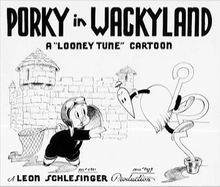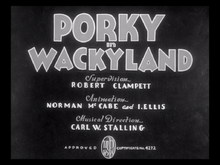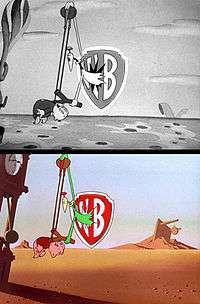Porky in Wackyland
| Porky in Wackyland | |
|---|---|
| Looney Tunes (Porky Pig) series | |
 Lobby card | |
| Directed by | Robert Clampett |
| Produced by |
Leon Schlesinger Ray Katz |
| Story by | Warren Foster (uncredited) |
| Voices by |
Mel Blanc (Various Other Characters-uncredited) Billy Bletcher (Roaring Goon- Uncredited) |
| Music by | Carl Stalling |
| Animation by |
Izzy Ellis Norman McCabe |
| Layouts by | Elmer Plummer |
| Backgrounds by | Elmer Plummer |
| Studio | Leon Schlesinger Productions |
| Distributed by |
Warner Bros. Pictures The Vitaphone Corporation |
| Release date(s) | September 24, 1938 (USA) |
| Running time | 7:22 |
Porky in Wackyland is a 1938 animated short film, directed by Robert Clampett for Leon Schlesinger Productions as part of Warner Bros.' Looney Tunes series.[1]
In this film Porky Pig goes hunting through a Salvador Dalí-esque landscape to find the Do-Do Bird for a very large bounty. In 1994 it was voted #8 of The 50 Greatest Cartoons of all time by members of the animation field and in 2000 was deemed "culturally, historically, or aesthetically significant" by the United States Library of Congress and selected the short for preservation in the National Film Registry.
Plot
A newspaper shows Porky traveling to Africa to hunt the rare dodo bird, worth four sextillion dollars. Porky uses his airplane to go to Dark Africa, then Darker Africa, and finally lands in Darkest Africa. When Porky lands, a sign tells him that he's in Wackyland ("Population: 100 nuts and a squirrel"), while a voice booms out "It can happen here!" Porky tiptoes along the ground in his airplane and he is greeted by a roaring beast, who suddenly becomes effeminate and dances away into the forest.

He watches as the sun is lifted above the horizon by a tower of stacked creatures. Nearby, another creature rises out of a tall flower, playing "The William Tell Overture", using his nose as a flute. The creature launches into a wild drum solo, plays a tiny piano, and plays its nose like a horn, which brings out many strange, weird, and oafish creatures, including a rabbit dangling in midair from a swing that seems to be threaded through its own ears, a small creature wearing large boots that encourages the rabbit to swing faster, a peacock with a fantail of cards, an upside-down creature walking with giant bare feet in his hands, a goofy looking creature wearing large glasses in a small pot, a little creature wearing oversized female mannequin legs, and an angry criminal imprisoned behind a free-floating barred window that he holds in his hands while a small policeman on a wheel appears and hits him on the head with a large stick. As Porky tries to find the do-do, he is distracted by a duck singing "Mammy!", a horn-headed creature, a conjoined cat and dog hybrid creature spinning around like a tornado while they fight, and a 3 headed stooge whose heads argue and fight amongst themselves.
Finally, the Dodo appears. Porky tries to catch it, but it plays tricks on him. The dodo pulls out a pencil and draws a door in mid-air, and instead of opening it and running through, reaches down and lifts up the bottom edge of the door like a curtain, darts underneath and lets it snap back into place for Porky to bump into. At another point, the do-do appears on the Warner Bros. shield logo and slingshots Porky into the ground. Porky is defeated when the dodo pulls a wall of bricks in the picture and lets him crash into it. At the end of the film, Porky triumphs when he disguises himself as a bearded paperboy, shouting "Extra! Extra! Porky captures Dodo!", before hitting the bird with a mallet. Porky loudly proclaims to the audience that he has captured the last dodo. The dodo mockingly replies, "Yes, I'm really the last of the dodos. Ain't I, fellas?". A multitude of dodos appear, all yelling out, "Yeah, man!". They and the Dodo all howl, which allows him to escape and stand on Porky's head.
Follow-ups and derivative works

Much of the Wackyland sequence was adapted and reused by Clampett for inclusion in his 1943 short Tin Pan Alley Cats. A color remake of Porky in Wackyland was supervised by Friz Freleng in 1948. Re-titled as Dough for the Do-Do, the remake was released in 1949. The films were nearly identical, in many cases appearing to match frame-by-frame in certain details, albeit with Porky's appearance updated (by redoing most of the animation of the character), the voices having evolved (with less use of speeding-up) and all of the backgrounds being different. The following differences include:
- Dough for the Do-Do was reissued as a Blue Ribbon Merrie Melodie.
- Dough for the Do-Do is a color cartoon instead of a black-and-white cartoon.
- The backgrounds are more desert-like with different objects, including melting pocket watches inspired by Salvador Dalí's The Persistence of Memory.
- During the beginning of Porky in Wackyland, a newspaper man arrives behind the title card, yelling "Extra! Extra! Porky off on dodo hunt!" before showing the paper to the camera ("Paper, mister?") In Dough for the Do-Do, this does not happen. The title card just fades to the newspaper already shown.
- In Porky in Wackyland, Porky shows a picture of the dodo in his airplane, after the newspaper is shown. In Dough for the Do-Do, this does not happen.
- In Dough for the Do-Do, after the sun is risen (with the "Ranz des Vaches" part of the William Tell Overture playing in the background), it cuts straight to the scene with the black duck passing by Porky and saying "Mammy!" (an allusion to Al Jolson's popular blackface performances). When the horn-head passes by, the drum solo starts, then cuts straight to the creature rising out of the flower and playing a jazz tune on his nose. In Porky in Wackyland, we see the creature playing that part of the William Tell Overture on his nose, then starting the jazz tune. After the shot with the horn-head and Cat-Dog, we see the flower-creature bang the drums some more and ends it with banging a cymbal on his head, which makes him and his flower sink into the ground. This and Cat-Dog are cut from Dough for the Do-Do.
- In Porky in Wackyland, the flower-creature plays his nose like a horn. In Dough for the Do-Do, the horn-nose is colored differently from the rest of creature's body, making it seem like the horn is separate from the creature.
- There are a lot more jungle sounds in Dough for the Do-Do.
- The long pan through Wackyland was used from Tin Pan Alley Cats.
- In Porky in Wackyland, the creature with large glasses had a pot, that showed the words "Treg's a Foo". In Dough for the Do-Do, the words were replaced with "ZOOT" in capital letters. The giant, three-dimensional "FOO" in the background is also replaced with "ZOOT".
- In Porky in Wackyland, after the angry criminal yells for a while, a short policeman on a wheel appears and clangs the criminal on the head with an oversized nightstick. In Dough for the Do-Do, this does not happen. Instead, it cuts to a new scene, featuring a reanimated version of Rubber Band marching by (i.e. marching instruments made out of rubber bands) from Tin Pan Alley Cats, before cutting straight to the Three Stooges scene.
- In Porky in Wackyland, the three-headed Stooge creature arrives from behind an igloo. In Dough for the Do-Do, it arrives behind a large broken guitar.
- In Dough for the Do-Do, Moe has blond hair. In Porky in Wackyland, he has his original black hair.
- In Dough for the Do-Do, Porky is led by a wacky candle-stick-headed creature to the dodo. He falls through a hole, and is seen falling from the sky. However, the camera zooms out to reveal that the sky is a "special-effects" projector, rolled by the creature with the candle stick on his head. When he stops rolling, Porky lands on the ground, and he "toot-toots" like a train, before running away. In Porky in Wackyland, this does not happen; Porky just lands in a dish, after tumbling through a path in a black background then coming out of a large faucet like a drop of water.
- In Dough for the Do-Do, the dodo has a green neck and yellow legs. In Porky in Wackyland, the dodo's neck and legs are black.
- In Porky in Wackyland, the dodo screams twice: after he draws the imaginary door and before he pulls the wall of bricks. In Dough for the Do-Do, his screams are muted.
- In one scene before the ending of Dough for the Do-Do, Porky crashes into a wall of bricks. He pokes his head out of the pile, and the Do-Do drops an extra brick from the clouds. Porky covers his head, panicked, until a parachute appears on the brick. Porky laughs in relief, until the brick releases a double, landing on Porky's head with a clang. In Porky in Wackyland, when Porky pokes his head out of the pile of bricks a brick drops on his head, then he cries.
- The major difference in storyline is the ending, where Porky dresses as another dodo, announcing himself to be the last dodo. The dodo handcuffs himself to Porky, claiming "I've got the last Dodo!" and runs with Porky to claim the reward. Porky reveals himself, and still handcuffed to the dodo, runs off with him, now proclaiming "I-I've got the last D-D-Dodo!" when suddenly, scores of dodos appear to confirm this. In Dough for the Do-Do, the other dodos do not appear until after Porky has left with the one dodo.
- In Porky in Wackyland, there is a sign that says "HELLO" upside-down above the creature with mannequin legs. In Dough for the Do-do, this doesn't happen. Instead it repeatedly says "Oh boy!"
- Dough for the Do-do is shorter.
Dough for the Do-Do was produced in Technicolor, but was originally released in Cinecolor due to a dispute with the Technicolor corporation. Later reissues were printed by Technicolor.
There were at least two Terrytoons plagiarizations of Porky in Wackyland in the 1940s or 50's. Dingbat Land (1949)[2] starred Sourpuss and Gandy Goose. The role of the Do-Do was taken by a minor Terry character, Dingbat.[3] The second film, a more direct plagiarization of the Porky Pig/Do-Do cartoons, starred a British hunter and a Do-Do stand-in. The creature didn't talk, but made strange hooting noises, and flung flames from a tuft of hair on top of its head.
Tex Avery, for whom Clampett worked as an animator in the mid-1930s, borrowed strongly from this cartoon for his 1948 MGM cartoons Half-Pint Pygmy (in which the characters, George and Junior, travel to Africa in search of the world's smallest pygmy, only to discover that he has an uncle who's even smaller) and The Cat That Hated People (where the cat travels to the moon and encounters an array of characters similar to those in Clampett's Wackyland, e.g., a pair of gloves and lips that keep saying "Mammy, mammy", just like the Al Jolson duck in Porky in Wackyland). Clampett would again use the Three Stooges parody when a later creation of his, Beany and Cecil, faced the "Dreaded Three-Headed Threep".
According to writer Paul Dini, the Do-Do Bird is the father of Gogo Dodo, a character on the 1990s animated TV series Tiny Toon Adventures. A small clip from the film was used in a Slappy Squirrel segment on another Warners animated TV series of the 1990s, Animaniacs. The segment, titled "Critical Condition", featured Porky in Wackyland as part of a fake Laserdisc release. The Do-Do Bird has made occasional guest spots in the DC Comics Looney Tunes comic book, being colored in grayscale as opposed to the rest of the art being in color. The character makes an appearance in the Wii game Looney Tunes: Acme Arsenal as an unplayable character. He is given a first name, Yoyo the Dodo. The character can also be seen in the beginning of Who Framed Roger Rabbit.
The "dodo bird" in this cartoon bears more than a passing resemblance to the metal eating bird that appears in "It's A Bird", a stop-motion animation short by Charles Bowers.[4]
Animator Jeff Hale may have borrowed Wackyland and Dodo's concept of the main character in a strange world surrounded by strange creatures for a Sesame Street cartoon segment featuring a boy on a bicycle suddenly riding into a Wackyland-esque neighborhood filled with very odd creatures and things, making him think he's lost, until a strange man with a magic yoyo appears and gives him a clue how to find his way back home: "Try to remember all the things you passed/But when you go back, make the first thing the last."
See also
- Looney Tunes and Merrie Melodies filmography (1929–1939)
- Looney Tunes and Merrie Melodies filmography (1940–1949)
- Looney Tunes Golden Collection Porky in Wackyland on Volume 2 (Disc 3) and Dough for the Do-Do on Volume 1 (Disc 2)
References
- ↑ "Porky in Wackyland". BCDB.com. Retrieved August 17, 2012.
- ↑ "Classic Cartoons". classiccartoons.blogspot.com.
- ↑ http://www.animationarchive.org/pics/terrylc08-big.jpg
- ↑ "The DVD Journal - Quick Reviews: Charley Bowers: The Rediscovery of an American Comic Genius". dvdjournal.com.
- Beck, Jerry and Friedwald, Will (1989): Looney Tunes and Merrie Melodies: A Complete Illustrated Guide to the Warner Bros. Cartoons. Henry Holt and Company.